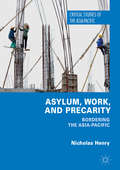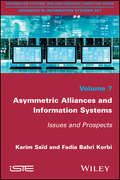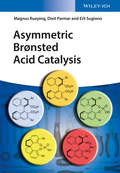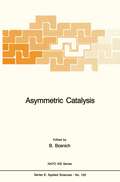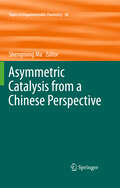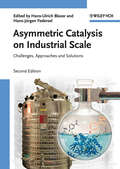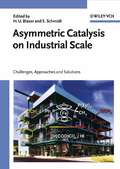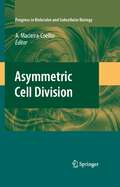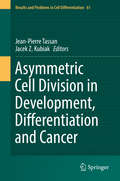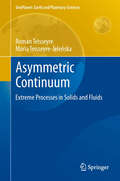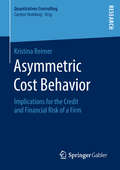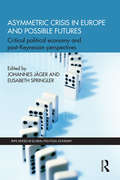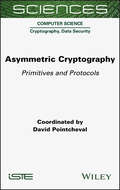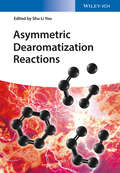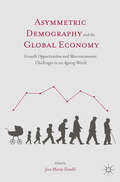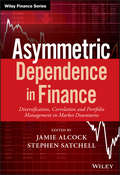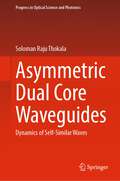- Table View
- List View
Asylum, Work, and Precarity: Bordering the Asia-Pacific
by Nicholas HenryThis book explores the regional coordination and impact of state responses to irregular migration in Southeast Asia and the Pacific. The main argument is that regional and international trends of securitisation and criminalisation of irregular migration, often associated with framing the issue in terms of migrant smuggling and human trafficking, have intensified carceral border regimes and produced greater precarity for migrants. Bilateral and multilateral processes of regional coordination at multiple levels of government are analysed with a focus on the impact on asylum seekers and migrant workers in major destination and transit countries including Malaysia, Thailand, Singapore, Indonesia, and Australia. The book will be of interest to a wide academic audience interested in the interdisciplinary field of Border Studies, as well as general readers concerned with the treatment of refugees and migrant workers who cross borders in search of safety, security, and a better life.
Asylum, Work, and Precarity: Bordering the Asia-Pacific
by Nicholas HenryThis book explores the regional coordination and impact of state responses to irregular migration in Southeast Asia and the Pacific. The main argument is that regional and international trends of securitisation and criminalisation of irregular migration, often associated with framing the issue in terms of migrant smuggling and human trafficking, have intensified carceral border regimes and produced greater precarity for migrants. Bilateral and multilateral processes of regional coordination at multiple levels of government are analysed with a focus on the impact on asylum seekers and migrant workers in major destination and transit countries including Malaysia, Thailand, Singapore, Indonesia, and Australia. The book will be of interest to a wide academic audience interested in the interdisciplinary field of Border Studies, as well as general readers concerned with the treatment of refugees and migrant workers who cross borders in search of safety, security, and a better life.
Asymmetric Alliances and Information Systems: Issues and Prospects
by Karim Said Fadia Bahri KorbiThis book explores the impact of information systems on the management of North–South asymmetric strategic alliances through a series of in-depth case studies which analyze different types of partnerships. Positioned at the heart of the value creation process, the choice of information system seems to be becoming a strategic issue which should be centered not only on the organizational decisions related to the type of alliance but also the management systems of each of the partners. The authors provide an understanding of the nature of this relationship between the organizational structure and the method of information system integration in asymmetric alliances. The in-depth analysis of strategic alliance case-studies illustrates the different methods of information system integration, which are themselves linked to the organisational and structural choices of the alliance. These methods are characterized by information-sharing and coordination mechanisms as well as the balance of control over shared activities developed by the distinct partners.
Asymmetric Alliances and Information Systems: Issues and Prospects
by Karim Said Fadia Bahri KorbiThis book explores the impact of information systems on the management of North–South asymmetric strategic alliances through a series of in-depth case studies which analyze different types of partnerships. Positioned at the heart of the value creation process, the choice of information system seems to be becoming a strategic issue which should be centered not only on the organizational decisions related to the type of alliance but also the management systems of each of the partners. The authors provide an understanding of the nature of this relationship between the organizational structure and the method of information system integration in asymmetric alliances. The in-depth analysis of strategic alliance case-studies illustrates the different methods of information system integration, which are themselves linked to the organisational and structural choices of the alliance. These methods are characterized by information-sharing and coordination mechanisms as well as the balance of control over shared activities developed by the distinct partners.
Asymmetric Bronsted Acid Catalysis
by Magnus Rueping Dixit Parmar Erli SugionoA much-needed overview of the synthesis of chiral Brønsted acids and their applications in various organic transformations. The internationally recognized and highly respected expert authors summarize the most significant advances in this new and dynamically progressing field, with a special emphasis on BINOL-derived phosphoric acids. They also describe other catalysts, such as C-H, TADDOL-derived Brønsted, and sulfonic acids. For easy navigation, the chapters are organized in the first instance according to reactive intermediate and then sub-divided by reaction type.An appendix with selected experimental details for benign and straight-forward procedures rounds of the book, making this the number-one information source for organic chemists in academia and industry.
Asymmetric Bronsted Acid Catalysis
by Magnus Rueping Dixit Parmar Erli SugionoA much-needed overview of the synthesis of chiral Brønsted acids and their applications in various organic transformations. The internationally recognized and highly respected expert authors summarize the most significant advances in this new and dynamically progressing field, with a special emphasis on BINOL-derived phosphoric acids. They also describe other catalysts, such as C-H, TADDOL-derived Brønsted, and sulfonic acids. For easy navigation, the chapters are organized in the first instance according to reactive intermediate and then sub-divided by reaction type.An appendix with selected experimental details for benign and straight-forward procedures rounds of the book, making this the number-one information source for organic chemists in academia and industry.
Asymmetric Catalysis (NATO Science Series E: #103)
by B. BosnichThe rate of advance in areas of science is seldom constant. Usually certain fields effloresce with activity because of the ~ealization that solutions are possible to long standing important problems. So it is now with asymmetric catalysis, a field which promises to change profoundly the strategic thinking of synthetic chemists. As this Report will show, reagents which can induce catalytic enantiocontrol of chemical transformations could represent the ultimate synthetic method. Nearly all synthetic strategies of complex molecules involve steps which require enantiocontrol and, in many cases, a specific catalytic transformation embodying enan tiocontrol has enormous advantages in terms of the rate and economy of the reaction. Because asymmetric catalysis is in a formative stage, workers with different backgrounds have joined the field. This Workshop had representatives with organometallic, organic, structural, kinetic, enzymatic, microbiological and industrial backgrounds. Each had his own perspective and this Report represents a consensus of this group of eleven people. The result is probably as compre hensive and balanced a view of the subject as is possible at present. It is hoped that those who have until now had but a glancing interest in asymmetric catalysis will find this Report a useful indication of its present state. We believe that asymmetric catalysis will have an increasing impact on the development of chemistry and will eventually dominate much of synthetic and industrial chemistry.
Asymmetric Catalysis from a Chinese Perspective (Topics in Organometallic Chemistry #36)
by Shengming MaQi-Lin Zhou and Jian-Hua Xie: Chiral Spiro Catalysts.- Fuk Loi Lam, Fuk Yee Kwong and Albert S. C. Chan: Chiral Phosphorus Ligands with Interesting Properties and Practical Applications.- Jiang Pan, Hui-Lei Yu, Jian-He Xu, Guo-Qiang Lin: Advances in Biocatalysis: Enzymatic Reactions and Their Applications.- Mei-Xiang Wang: Enantioselective Biotransformations of Nitriles.- Man Kin Wong, Yiu Chung Yip and Dan Yang: Asymmetric Epoxidation Catalyzed by Chiral Ketones.- W. J. Liu, N. Li and L. Z. Gong: Asymmetric Organocatalysis.- Qing-Hua Fan and Kuiling Ding: Enantioselective Catalysis with Structurally Tunable Immobilized Catalysts.- Chang-Hua Ding, Xue-Long Hou: Transition Metal-Catalyzed Asymmetric Allylation.- Jian Zhou and Yong Tang: Enantioselective Reactions with Trisoxazolines.- Xiang-Ping Hu, Duo-Sheng Wang, Chang-Bin Yu, Yong-Gui Zhou, and Zhuo Zheng: Adventure in Asymmetric Hydrogenation: Synthesis of Chiral Phosphorus Ligands and Asymmetric Hydrogenation of Heteroaromtics.
Asymmetric Catalysis on Industrial Scale: Challenges, Approaches and Solutions
by Hans Ulrich Blaser Hans-J 252 Rgen FederselThis second edition of the pioneering work on this hot topic captures the major trends and latest achievements in the art of asymmetric catalysis on an industrial scale. A number of completely new real-life case studies written by the world leaders in their respective areas provide a compact and qualified insight into this developing field. The resulting ready reference and handbook collates first-hand and valuable information within a context where it can be easily found. The high-quality contributions illustrate the relevant environments and situations, such as time pressure, how the catalytic step fits into the overall synthesis, or competition with other synthetic approaches, as well as the typical problems encountered in the various phases, including finding/developing the catalyst and optimization of the process or choice of equipment. Both successful and unsuccessful approaches to solve these problems are described.
Asymmetric Catalysis on Industrial Scale: Challenges, Approaches and Solutions
by Hans Ulrich Blaser Elke SchmidtEdited by two of the experts in the field, the central aim is to show organic chemists working in process development that enantioselective catalysis is suitable for the large-scale production of enantioenriched intermediates. In so doing, it is equally a source of information and inspiration for academic research, and, with its contribution by Noble prizewinner W. S. Knowles, will also heighten the status of industrial catalyst specialists working in the exciting field of enantioselective catalysis. Some 25 contributions from top industrial researchers around the world present case studies on the development of the widest possible range of large-scale enantioselective processes, featuring stereoselective production processes of fine-chemicals, agrochemicals and pharmaceuticals. Clearly structured according to the nature of the task, this handbook adopts a problem-driven approach such that readers can easily find how colleagues have dealt with a similar situation.
Asymmetric Catalysis on Industrial Scale: Challenges, Approaches and Solutions
by Hans-Ulrich Blaser et al.This second edition of the pioneering work on this hot topic captures the major trends and latest achievements in the art of asymmetric catalysis on an industrial scale. A number of completely new real-life case studies written by the world leaders in their respective areas provide a compact and qualified insight into this developing field. The resulting ready reference and handbook collates first-hand and valuable information within a context where it can be easily found. The high-quality contributions illustrate the relevant environments and situations, such as time pressure, how the catalytic step fits into the overall synthesis, or competition with other synthetic approaches, as well as the typical problems encountered in the various phases, including finding/developing the catalyst and optimization of the process or choice of equipment. Both successful and unsuccessful approaches to solve these problems are described.
Asymmetric Cell Division (Progress in Molecular and Subcellular Biology #45)
by Alvaro Macieira-CoelhoCell biologists have recently come to understand that asymmetry of division is an important regulatory phenomenon in the fate of a cell. In adult organisms asymmetric divisions regulate the stem cell reservoir and are a source of the drift that contributes to aging. This book describes the phenomenon in different organisms and addresses its implications for the development of the organism, cell differentiation, human aging and the biology of cancers.
Asymmetric Cell Division in Development, Differentiation and Cancer (Results and Problems in Cell Differentiation #61)
by Jean-Pierre Tassan Jacek Z. KubiakThis book provides readers with an overview of the frequent occurrence of asymmetric cell division. Employing a broad range of examples, it highlights how this mode of cell division constitutes the basis of multicellular organism development and how its misregulation can lead to cancer.To underline such developmental correlations, readers will for example gain insights into stem cell fate and tumor growth. In turn, subsequent chapters include descriptions of asymmetric cell division from unicellular organisms to humans in both physiological and pathological conditions. The book also illustrates the importance of this process for evolution and our need to understand the background mechanisms, offering a valuable guide not only for students in the field of developmental biology but also for experienced researchers from neighboring fields.
Asymmetric Continuum: Extreme Processes in Solids and Fluids (GeoPlanet: Earth and Planetary Sciences #3)
by Roman Teisseyre Maria Teisseyre-JeleńskaThis book deals with a class of basic deformations in Asymmetric Continuum Theory. It describes molecular deformations and transport velocities in fluids, strain deformations in solids as well as the molecular transport, important in fracture processes. In solids, a separate problem relates to the displacements; their recording, e.g., by means of the seismometers, proves only the existence of the displacement derivatives and not a real displacement. However, the molecular displacements and new fracture criterion including the defect distributions and induced strains are defined in the book too. In fluids, the transport velocities and molecular strains describe the motion processes. The vortex motions are defined by means of the rotational transport; this approach leads to more complicated problems, like the turbulence phenomena. The interaction processes, including the electric and magnetic fields, and some thermodynamical problems and quantum theory analogies help to understand the extreme processes
Asymmetric Cost Behavior: Implications for the Credit and Financial Risk of a Firm (Quantitatives Controlling)
by Kristina ReimerThe thesis of Kristina Reimer provides a comprehensive analysis of asymmetric cost behavior (also known as cost stickiness) by discussing its origin and development in the theoretical and empirical research from the 1920s of the past century up until today. Further, using an empirical approach, she investigates the implications of asymmetric cost behavior for credit and financial risk of a firm. In addition, she provides an introduction into credit risk fundamentals by focusing on credit default swaps. Thereby she analyses the development of credit default swap market as well as the components of credit spreads. Finally, she provides several suggestions for future research.
Asymmetric Crisis in Europe and Possible Futures: Critical Political Economy and Post-Keynesian Perspectives (RIPE Series in Global Political Economy)
by Elisabeth Springler Johannes JägerThe crisis in Europe is often discussed as a crisis of European integration or a crisis of national economies within Europe. Both the ‘methodological Europeanism’ and ‘methodological nationalism’ miss out the important links between economic and political processes at different spatial scales within Europe, and therefore, asymmetries and phenomena of uneven development. In addition, a discussion of possible scenarios which systematically addresses the implications of anti-crisis policies is missing. This volume seeks to close this gap by systematically integrating the analysis of economic policy or ‘technical’ solutions to the crisis within a broader framework of political economy. It argues that combining critical political economy approaches and post-Keynesian perspectives allows for a systematic understanding of the economic and political dimensions of the crisis. Although both approaches have the capacity to deal with asymmetries and uneven development, the heterogeneity in Europe has been an often largely neglected dimension of analysis. However, this recent crisis has shown that this is an essential dimension which has to be addressed in order to better understand the dynamics of European development and integration. Hence, this book aims to deal with asymmetries in Europe and to bridge the gap between the two perspectives. This work will initiate an integrative debate that is crucial for a deeper understanding of the current crisis and is an important resource for all students and scholars of IPE, European political economy and European politics.
Asymmetric Crisis in Europe and Possible Futures: Critical Political Economy and Post-Keynesian Perspectives (RIPE Series in Global Political Economy)
by Elisabeth Springler Johannes JägerThe crisis in Europe is often discussed as a crisis of European integration or a crisis of national economies within Europe. Both the ‘methodological Europeanism’ and ‘methodological nationalism’ miss out the important links between economic and political processes at different spatial scales within Europe, and therefore, asymmetries and phenomena of uneven development. In addition, a discussion of possible scenarios which systematically addresses the implications of anti-crisis policies is missing. This volume seeks to close this gap by systematically integrating the analysis of economic policy or ‘technical’ solutions to the crisis within a broader framework of political economy. It argues that combining critical political economy approaches and post-Keynesian perspectives allows for a systematic understanding of the economic and political dimensions of the crisis. Although both approaches have the capacity to deal with asymmetries and uneven development, the heterogeneity in Europe has been an often largely neglected dimension of analysis. However, this recent crisis has shown that this is an essential dimension which has to be addressed in order to better understand the dynamics of European development and integration. Hence, this book aims to deal with asymmetries in Europe and to bridge the gap between the two perspectives. This work will initiate an integrative debate that is crucial for a deeper understanding of the current crisis and is an important resource for all students and scholars of IPE, European political economy and European politics.
Asymmetric Cryptography: Primitives and Protocols
by David PointchevalPublic key cryptography was introduced by Diffie and Hellman in 1976, and it was soon followed by concrete instantiations of public-key encryption and signatures; these led to an entirely new field of research with formal definitions and security models. Since then, impressive tools have been developed with seemingly magical properties, including those that exploit the rich structure of pairings on elliptic curves. Asymmetric Cryptography starts by presenting encryption and signatures, the basic primitives in public-key cryptography. It goes on to explain the notion of provable security, which formally defines what "secure" means in terms of a cryptographic scheme. A selection of famous families of protocols are then described, including zero-knowledge proofs, multi-party computation and key exchange. After a general introduction to pairing-based cryptography, this book presents advanced cryptographic schemes for confidentiality and authentication with additional properties such as anonymous signatures and multi-recipient encryption schemes. Finally, it details the more recent topic of verifiable computation.
Asymmetric Cryptography: Primitives and Protocols
by David PointchevalPublic key cryptography was introduced by Diffie and Hellman in 1976, and it was soon followed by concrete instantiations of public-key encryption and signatures; these led to an entirely new field of research with formal definitions and security models. Since then, impressive tools have been developed with seemingly magical properties, including those that exploit the rich structure of pairings on elliptic curves. Asymmetric Cryptography starts by presenting encryption and signatures, the basic primitives in public-key cryptography. It goes on to explain the notion of provable security, which formally defines what "secure" means in terms of a cryptographic scheme. A selection of famous families of protocols are then described, including zero-knowledge proofs, multi-party computation and key exchange. After a general introduction to pairing-based cryptography, this book presents advanced cryptographic schemes for confidentiality and authentication with additional properties such as anonymous signatures and multi-recipient encryption schemes. Finally, it details the more recent topic of verifiable computation.
Asymmetric Dearomatization Reactions
by Shu-Li YouThe first comprehensive account of the rapidly growing field of asymmetric dearomatization reactions with a focus on catalytic methods. It introduces the concept of dearomatization and describes recent progress in asymmetric reaction procedures with different catalyst systems, such as organocatalysts, transition metal catalysts, and enzymes. Chapters on dearomatizations of electron-deficient aromatic rings, dearomatization reactions via transition metal-catalyzed cross-couplings as well as dearomatization strategies in the synthesis of complex natural products are also included. Written by pioneers in the field, this is a highly valuable source of information not only for professional synthetic chemists in academia and industry but also for all those are interested in asymmetric methodologies and organic synthesis in general.
Asymmetric Dearomatization Reactions
by Shu-Li YouThe first comprehensive account of the rapidly growing field of asymmetric dearomatization reactions with a focus on catalytic methods. It introduces the concept of dearomatization and describes recent progress in asymmetric reaction procedures with different catalyst systems, such as organocatalysts, transition metal catalysts, and enzymes. Chapters on dearomatizations of electron-deficient aromatic rings, dearomatization reactions via transition metal-catalyzed cross-couplings as well as dearomatization strategies in the synthesis of complex natural products are also included. Written by pioneers in the field, this is a highly valuable source of information not only for professional synthetic chemists in academia and industry but also for all those are interested in asymmetric methodologies and organic synthesis in general.
Asymmetric Demography and the Global Economy: Growth Opportunities and Macroeconomic Challenges in an Ageing World
by José María FanelliThe global demographic transition presents marked asymmetries as poor, emerging, and advanced countries are undergoing different stages of transition. Emerging countries are demographically younger than advanced economies. This youth is favorable to growth and generates a demographic dividend. However, the future of emerging economies will bring a decline in the working-age share and a rise in the older population, as is the case in today's developed world. Hence, developing countries must get rich before getting old, while advanced economies must try not to become poorer as they age. Asymmetric Demography and the Global Economy contributes to our understanding of why this demographic transition matters to the domestic macroeconomics and global capital movements affect the asset accumulation, growth potential, current account, and the economy's international investment position. This collaborative collection approaches these questions from the perspective of "systemically important" emerging countries i.e., members of the G20 but considers both the national and the global sides of the problem.
Asymmetric Dependence in Finance: Diversification, Correlation and Portfolio Management in Market Downturns (Wiley Finance)
by Jamie Alcock Stephen SatchellAvoid downturn vulnerability by managing correlation dependency Asymmetric Dependence in Finance examines the risks and benefits of asset correlation, and provides effective strategies for more profitable portfolio management. Beginning with a thorough explanation of the extent and nature of asymmetric dependence in the financial markets, this book delves into the practical measures fund managers and investors can implement to boost fund performance. From managing asymmetric dependence using Copulas, to mitigating asymmetric dependence risk in real estate, credit and CTA markets, the discussion presents a coherent survey of the state-of-the-art tools available for measuring and managing this difficult but critical issue. Many funds suffered significant losses during recent downturns, despite having a seemingly well-diversified portfolio. Empirical evidence shows that the relation between assets is much richer than previously thought, and correlation between returns is dependent on the state of the market; this book explains this asymmetric dependence and provides authoritative guidance on mitigating the risks. Examine an options-based approach to limiting your portfolio's downside risk Manage asymmetric dependence in larger portfolios and alternate asset classes Get up to speed on alternative portfolio performance management methods Improve fund performance by applying appropriate models and quantitative techniques Correlations between assets increase markedly during market downturns, leading to diversification failure at the very moment it is needed most. The 2008 Global Financial Crisis and the 2006 hedge-fund crisis provide vivid examples, and many investors still bear the scars of heavy losses from their well-managed, well-diversified portfolios. Asymmetric Dependence in Finance shows you what went wrong, and how it can be corrected and managed before the next big threat using the latest methods and models from leading research in quantitative finance.
Asymmetric Dependence in Finance: Diversification, Correlation and Portfolio Management in Market Downturns (Wiley Finance)
by Jamie Alcock Stephen SatchellAvoid downturn vulnerability by managing correlation dependency Asymmetric Dependence in Finance examines the risks and benefits of asset correlation, and provides effective strategies for more profitable portfolio management. Beginning with a thorough explanation of the extent and nature of asymmetric dependence in the financial markets, this book delves into the practical measures fund managers and investors can implement to boost fund performance. From managing asymmetric dependence using Copulas, to mitigating asymmetric dependence risk in real estate, credit and CTA markets, the discussion presents a coherent survey of the state-of-the-art tools available for measuring and managing this difficult but critical issue. Many funds suffered significant losses during recent downturns, despite having a seemingly well-diversified portfolio. Empirical evidence shows that the relation between assets is much richer than previously thought, and correlation between returns is dependent on the state of the market; this book explains this asymmetric dependence and provides authoritative guidance on mitigating the risks. Examine an options-based approach to limiting your portfolio's downside risk Manage asymmetric dependence in larger portfolios and alternate asset classes Get up to speed on alternative portfolio performance management methods Improve fund performance by applying appropriate models and quantitative techniques Correlations between assets increase markedly during market downturns, leading to diversification failure at the very moment it is needed most. The 2008 Global Financial Crisis and the 2006 hedge-fund crisis provide vivid examples, and many investors still bear the scars of heavy losses from their well-managed, well-diversified portfolios. Asymmetric Dependence in Finance shows you what went wrong, and how it can be corrected and managed before the next big threat using the latest methods and models from leading research in quantitative finance.
Asymmetric Dual Core Waveguides: Dynamics of Self-Similar Waves (Progress in Optical Science and Photonics #22)
by Soloman Raju ThokalaThis book highlights the dynamical behavior of self-similar waves in asymmetric dual-core waveguides. The proposed dual-core waveguide consists of two closely spaced adjoining fibers in which one fiber is active and the other is passive. Due to the linear coupling between them, the dynamics of the wave propagating through the passive core can be controlled by manipulating the dynamics of the wave propagating in the active core. The optimal pulse compression or amplification of these waves as the length of the fiber tends to infinity is presented. The exact Mobius transform self-similar solutions that propagate through these waveguides self-similarly are subject to simple scaling rules. The book includes experiments conducted to corroborate the analytical predictions.
